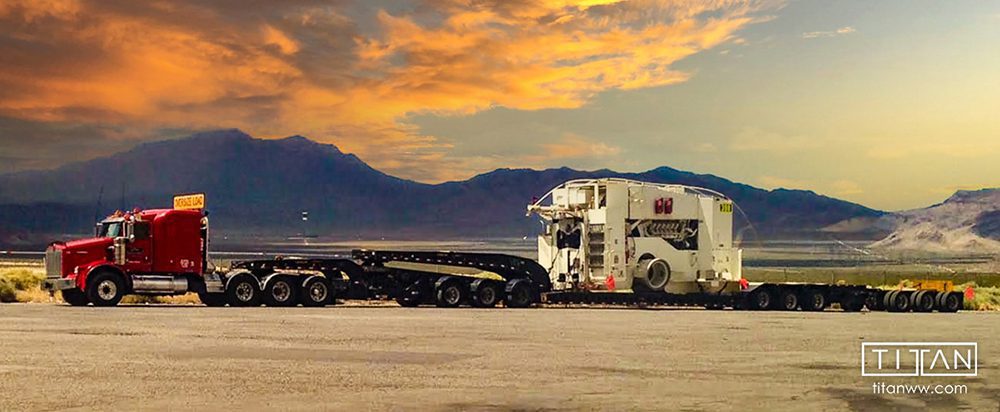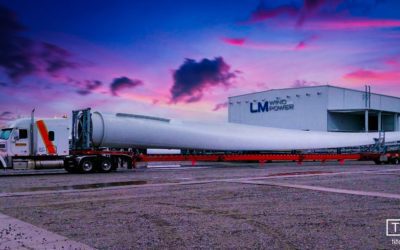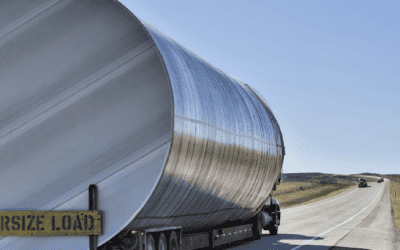Oversize Load Transport: Overview and Regulations
We’ve all been on the highway in our lives, and had the opportunity to see giant equipment being hauled by an even bigger truck. For heavy equipment, construction equipment, and other oversized items — the highway is the most practical means for oversize load transport jobs.
If you need something transported or are just interested in oversized transportation, this blog will be helpful for you!
Defining Oversized and Overweight Loads
Oversized Loads
Let’s take a look at oversized loads first. An oversized load is any equipment or cargo that exceeds one or more legal maximum dimensions of width, height, and/or length.
Some oversized equipment may be disassembled and reassembled to bypass being classified as oversized. However, it is more common for oversized equipment to be “non-divisible”, meaning that they cannot be easily broken down to more suitable loads during the transportation process.
Currently, the most commonly exceeded dimension is width – meaning that for oversized load transport, the driver will need to get over-width permits. In the United States, the maximum width for a “normal” load is 8.5 feet in every state. The reason that width limits are uniform in the states is because of the National Network’s system of interstate highways. These major interstate highways range around 12 feet in width, ensuring nearly 2 feet on each side of the vehicle or load if the load is at normal width. Having space on both sides of the vehicle or load provides buffer room to increase safety and prevent damages to goods.
Any load or equipment that exceeds 8.5 feet in width — such as a 12 feet width bulldozer or a 15 feet width pre-built home — is then an oversized “wide” load that requires oversize transportation permits and additional travel procedures to ensure safety.
As mentioned before, height and length are also considerations when looking at what is oversized. Unlike the uniform width limit, the lack of uniformity in height and length limits makes these dimensions a bit more confusing. The typical legal height maximum will range between 13.5 and 14.5 feet, while the legal overall length maximum can extend up to 75 feet under certain conditions. Loads that bypass these height and length dimensions may be transported provided that special permits are secured.
It is also important to note that loads may exceed the legal length, but there are circumstances in which only a safety flag note is needed to be transported legally.
Overweight Loads
Now, let’s talk about overweight loads. Most of the time, oversized loads will also be overweight because of the relationship between size and weight. But, overweight loads may fit into traditional 43-feet trailers without any problem.
Overweight loads do not need to exceed width, height, and length dimensions. The only dimension that is used to consider if a load is overweight is — well, you can probably guess — weight.
For weight, using the National Network’s highways, the legal maximum permissible gross vehicle weight for legal loads is 80,000 pounds. These 80,000 pounds are a combination of the vehicle weight and the load/equipment weight.
There are further limitations based on the maximum weights handled by each individual axle. Federal laws regulate maximum weight for traditional axles at 20,000 pounds and 34,000 pounds for tandem axles and others. But, a transport company will need to look at different state regulations before they can begin the trip.
Examples of Oversized and Overweight Loads
Overweight and oversize shipping companies can move almost anything provided that safety standards and permit needs are met. These are common examples of oversized and overweight loads:
- Construction machines (bulldozers, cranes, front loaders, etc.)
- Quarry and mining equipment
- Pre-built homes
- Beams
- Raw material
- Generators
- Wind generator propellers
- Containers
If you don’t know if your equipment or load qualifies as an oversized/overweight load — contact us! We’d be more than happy to help.
Why Regulations Are Enforced
The reason overweight and oversize load trucking classifications are enforced is to protect the general public. For oversized loads, they might be hazards to other traffic and pedestrians. For overweight loads, these vehicles may cause direct damage to highways and bridges if they exceed the load carrying limit on that roadway.
What Realms of Life Does Oversized and Overweight Loads Influence?
Oversized and overweight load transportation actually reaches into more facets of life than you would typically think. Here’s how these loads affect industries and your life.
Overweight and Oversized Load Transport Industry — There are at least hundreds of transport trucks traveling on any given highway throughout the day. People need oversized and overweight equipment transported on oversized load haulers, and the trucking industry has bloomed. The industry has its own complexities. Besides trucking companies and their drivers, the industry consists of brokers who contract their services, vendors, contract escort vehicle operators, and customers.
Commerce — Commerce is a huge industry, and that calls for a demand to ship cargo and equipment of all shapes and sizes. Imagine a giant sculpture or statue, we would be the ones who could that type of cargo. Commerce may require the haul of cargo and equipment beyond traditional load sizes, and the trucking industry can help.
Military and Government — Just like commerce, the military and government may need to ship very large pieces of equipment interstate or internationally. The transportation of heavy armor, machinery, and/or raw material from a point of transport to a point of use is essential. These tasks fall into the hands of oversized and overweight trucking companies.
State Highway Departments — Oversize load shipping equipment require licenses and special procedures. That means that state highway departments will need to staff workers to issue licenses and provide these said procedures.
The General Public — Oversize load transport can interrupt the normal flows of life if the load is big enough. As loads get bigger, they require special operations that can interrupt the flow of traffic, block lanes, and cause delays. Most municipal areas will restrict the movement of oversize loads during normal business rush hours or near schools, but there may be exceptions during emergencies.
Outline of Federal and State Regulations
Through the Federal Highway Administration (FHWA) and the Code of Federal Regulations (CFR), the federal government defines the size and weight standards of loads. However, because the FHWA is not involved in the day-to-day processes of trucking carriers, states are the ones who ultimately enforce the rules. Individual states are responsible for ensuring that all motor vehicles comply with both state and federal standards. Having total control of state standards, this is the primary reason why length, height, and weight regulations are so different for each state.
These standards apply to all highways covered by the National Network. This includes the interstate highway system and all other federal highways capable of handling heavier vehicles. State highways may not be built with federal standards in mind, meaning that they are unable to support heavier loads due to weight limits. At the moment, the National Network has over 200,000 miles of highway. There are also federal highways designated specifically for especially large and/or heavy equipment/loads.
While it might feel like a nuisance to get additional permits, apply for special accommodations, and/or be delayed due to using federal highways — regulations have been set with a purpose. The purpose of setting these oversize and overweight standards is to ensure the safety of the general public, while keeping the infrastructure of roads secure.
Regulations and State Permits
We’ve mentioned permits several times already — but what’s that all about? States grant and require special use permits to motor vehicles that carry cargo that exceed the 8.5 width feet limitation. Additional permits are required depending on if height, length, and/or weight exceeds that of normal loads.
On a oversize load shipping permit, there are usually specifications on the specific route that the vehicle must follow, along with specific dates and times during which the load may travel. The requirements and additional procedures of the transport are often laid out on the permit as well. Additional procedures and/or requirements may include specific time of travel and weather condition scenarios.
When working with an oversize and overweight transport company, they will often handle the license paperwork for customers.
To find specific regulations for different states, click here.




